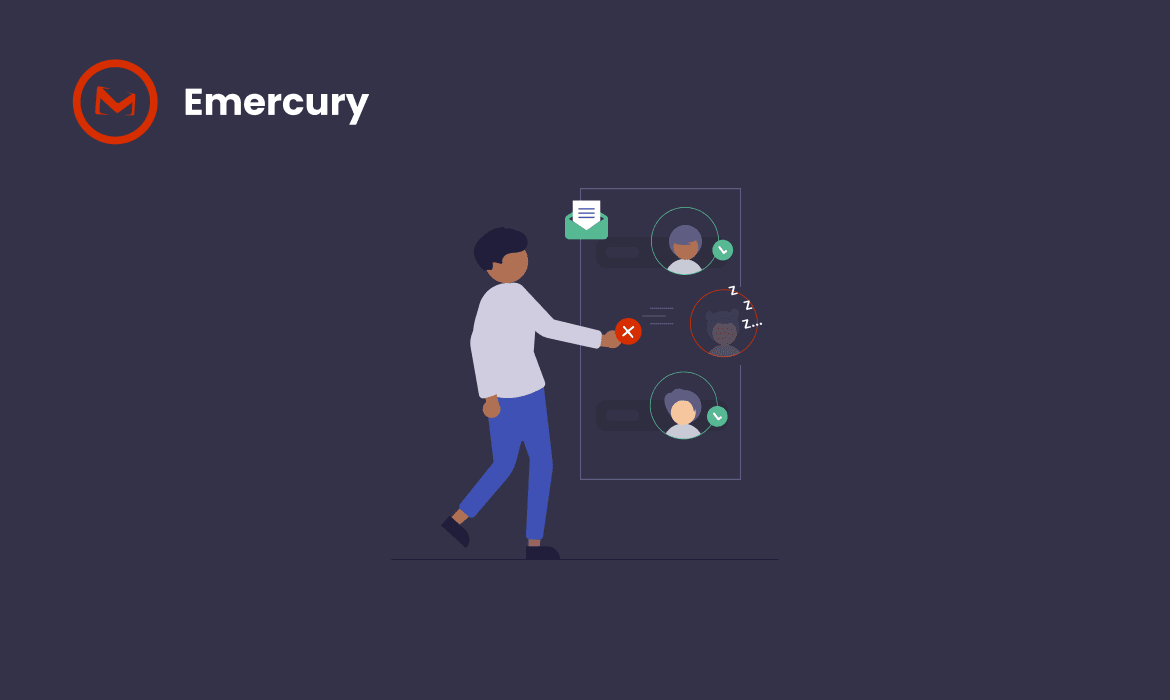 I have some really bad news to share with you today. Did you know that the number one reason people mark your emails as spam is if you get the email frequency wrong? It’s also the leading cause of unsubscribes and overall subscriber dissatisfaction as well.
I have some really bad news to share with you today. Did you know that the number one reason people mark your emails as spam is if you get the email frequency wrong? It’s also the leading cause of unsubscribes and overall subscriber dissatisfaction as well.
But wait, it gets even trickier. Most people assume it is only a problem if you send too many emails. So they go ahead and send way less emails than what is necessary for optimal engagement and conversions.
Infrequent sending can also be dangerous because it can negatively impact your brand recognition and email deliverability. So the trick is to send at just the right amount.
However, the right frequency is different for everyone. It is different for each type of business, but also for each type of subscriber on your list as well. The good news is that we prepared this guide chock full of best practices to help you make sense of things and put you on the right track.
Consider the customer lifecycle
If you’re not familiar with the concept of the “life cycle” in marketing, it refers to the fact that most customers go through several stages. They might go from someone who’s barely aware of your existence to someone who’s passionate about your brand, or even an evangelist. And there are quite a few stages in between these two points.
 The frequency at which you want to send emails is highly correlated to the stage that the lead or customer is in. People who want to oversimplify things might say “just send less emails to new subscribers”, but it is a bit more complicated than that.
The frequency at which you want to send emails is highly correlated to the stage that the lead or customer is in. People who want to oversimplify things might say “just send less emails to new subscribers”, but it is a bit more complicated than that.
Whilst in general you want to increase emails over time, there are two factors that make this oversimplification less than useful.
First, it’s more about engagement than how long an address has been in your email list. Take someone that has been a subscriber for years but rarely opens your emails. Should they get more emails than someone who signed up a few months ago, but gladly opens and engages with all of your emails?
Secondly, “welcome email series” are a special exception to most rules in email marketing. This includes email frequency. You can, and you should have a somewhat high “sending frequency” during the span of the welcome series. Even if you haven’t yet established whether this is a lead that needs to go in the “low frequency” or “high frequency” bucket.
For example it’s typical for a welcome series to include 3-6 emails over a span of just 1-2 weeks. Outside of a welcome series, this might be too high of a frequency except for the most engaged subscribers. However, it’s normal to have this frequency for most or even all new subscribers, provided the welcome series makes sense.
Understand your audience
The first major marketing principle that applies to all of marketing is the life cycle, and the second one is the idea of a “customer persona”.
In practice however, we go beyond the traditional “persona” as it was used in offline marketing back in the 20th century. It is a lot more practical to think in terms of “segments”. Some of these segments can be based on things similar to the traditional “persona”, but they can also be “behavior-based”.
For example you might want to create a segment for people who are highly engaged with your emails. You can also can tag people differently based on which pages they visit on your website. Or you can set custom field values based on whether they opened one email or another.
There are actually many ways to go about this, and plenty of options at your disposal. We discuss and demystify the different options inside our super-popular guide: The Art of Email Segmentation: Tags, Lists, and Segments Demystified.
Focus on value and engagement
Are you getting overwhelmed with all of this talk about getting frequency “just right”? If you’re like me, you might even start worrying about getting it wrong. The good news is that if you focus on this one thing, subscribers will be a lot more forgiving. And I’m talking about engagement.
 The fact is that it is easy to focus on one thing in email marketing, and forget about everything else. The same thing can happen when you first learn about email frequency. But remember, frequency is just one of the factors behind improving engagement. It is not the only factor.
The fact is that it is easy to focus on one thing in email marketing, and forget about everything else. The same thing can happen when you first learn about email frequency. But remember, frequency is just one of the factors behind improving engagement. It is not the only factor.
Sending high-quality content, delivering value and building a relationship is just as important as getting the frequency right. In fact, it is probably even more important. And I don’t mean just because people are more forgiving. It is impossible to send too many, or too few emails if you genuinely focus on building a relationship.
Personalize or perish
Did you know that “irrelevant” content is the reason behind 31.6% of spam complaints? And “lack of personal approach” clocks in at 10.4%. If you combine the two, it means that failing to personalize is just as bad as having a really terrible frequency.
And remember, everything ties in together here. Having the “wrong frequency” itself is a relative matter. No frequency is universally wrong, because it’s different for different types of subscribers. And this is why we discussed learning more about email segmentation.
If segmentation is the theory, then personalization is the practice. In fact, the only reason why we engage in segmentation is so that we have more powerful ways to personalize the subscriber experience.
You can, and you should start out with the basics
I’m talking about things like referring to customers by their first name. However, you can take that further by first utilizing smart personalization, and then going even further into giving people even more personalized experiences. As always, I recommend starting out with the simple stuff, and getting more advanced over time.
And when I say more advanced I’m talking about things such as leveraging workflows that automatically tag people based on their behaviors or events. Or utilizing smart segments that auto-update the moment a person’s data points qualify them for such a segment.
This can, and should obviously include tracking things that indicate data points relevant to interest levels. And with this, you can then send more emails to those who you’ve identified as more highly engaged.
In either case, any personalization that you do will help whilst you’re busy figuring out the right frequency. Again, just like with focusing on value, if you use personalization, subscribers will be a lot more forgiving if you utilize personalization.
Conversely, the same survey which asked why people spam your emails, asked what they would like to see more of. A full 24.2% said “more informative content”, and 23.9% said “more personalized offers”. Aside from confirming the importance of personalization, it also reminds us about the previous point about delivering more value through engaging quality content.
Prioritize consistency
When people think of email frequency, they mostly think of “how often you send”. However, it is inconsistency that hurts marketers more than anything else. In fact, it’s probably the most common mistake I discover when I help businesses.
 And being inconsistent isn’t just about getting “subpar” results. It almost guarantees that you will annoy your subscribers and destroy your deliverability. And this is for a very simple reason. Subscribers are creatures of habit.
And being inconsistent isn’t just about getting “subpar” results. It almost guarantees that you will annoy your subscribers and destroy your deliverability. And this is for a very simple reason. Subscribers are creatures of habit.
If they’re used to getting 1 email a month from you, and then you suddenly send 2 emails a week, they will spam you. And I don’t mean because “2 emails a week is too much”. The main reason is that the bump came out of nowhere. Odds are that if you ramped it up gradually, you might have gotten to that volume and they would be fine with it.
How to avoid inconsistency
Running a business can be difficult and unpredictable. You don’t know when issues will come up, and that’s normal. However, I also find this is the main reason behind inconsistency for a lot of businesses. And inconsistency in turn is the main way businesses destroy their email lists.
A lot of businesses will have a “highly motivated” period where they do a bunch of email marketing. They will get all excited about email marketing and just send a ton of overly-excited emails. And I mean high-quality, valuable emails.
But then, something else will happen in their business. Perhaps an urgency, or they’ll switch to focusing on another part of business. Their volume will drop out of nowhere, and cause a massive issue for their list.
Even worse, some will go silent for months and forget about email marketing altogether. And then many months later, they come back to email marketing, and bombard their subscribers out of nowhere. A true recipe for disaster.
The trick is to plan in advance and be pessimistic about your output. If you can produce 12 emails in a highly motivated period, don’t make “12 emails a month” your emailing frequency. Assume you will have bad months and stockpile some of that content.
You might decide to set your “consistency rate” at just 4 emails a month (even if you think you can write 12). If you have stay consistent in terms of volume for months on end, it might be ok to increase the “consistency rate”.
Now, that doesn’t mean that you increase the frequency for your entire list. You’ve proven you can be consistent at a higher volume, but increase in segments. Some subscribers will be happy about getting more emails, some won’t. When we say it’s ok to bump up the volume after being consistent, we mean for the segments that qualify.
Implement a preferences center
Customers love it when they feel a sense of respect coming from your brand. The more customization power you can put in their hands, the better. And one of the best things you can do is to implement a fully custom “preferences center”.
This might seem like a complex undertaking, but it is actually surprisingly easy. You can just build a form using any of the form solutions that we integrate with. Then, simply assign tags or custom field-values to the subscriber based on what they selected on the form. Next, just craft your automations and segments to factor in those preferences.
If you love high-ROI hacks, I have to say this is one of the highest ROI things you can do. It might prevent a whole bunch of unnecessary unsubscribes. You might have even noticed that many of your favorite brands have this.
The most common approach is to present this as alternative to unsubscribing. That is because most unsubscribes have to do with things you can fix when the subscriber states preferences explicitly. Just place the link to the preferences center next to, or close to the unsubscribe link.
Test, track and adjust
This guide is all about giving you direction and awareness. You will however, have to actually track your results in the real world and adjust. I don’t think it’s possible to get frequency right from day one. You will have to test different things out and learn over time.
 The good news is that analytics and testing in email marketing are super simple, and especially so if you’re using Emercury. Unlike with other channels, you only have 2 or 3 metrics to track to get the full picture. The open rate, the click rate and the unsubscribe rate will tell you everything you need to know about how things are going.
The good news is that analytics and testing in email marketing are super simple, and especially so if you’re using Emercury. Unlike with other channels, you only have 2 or 3 metrics to track to get the full picture. The open rate, the click rate and the unsubscribe rate will tell you everything you need to know about how things are going.
Let’s look at a more specific example. Let’s say that you’re experimenting with higher frequency and you find that your open rates are going down (or unsubscribers going up). This is proof positive that you have increased your frequency too much. Does it mean that frequency is proven wrong for everyone, and forever? No, not really. It could be due to increasing it too suddenly, or increasing it for the wrong segment. The point is you have to keep testing.
In terms of numbers to test again, you need two things: your own previous numbers, and the industry standard. Most email marketers see open rates of about 20%. If your open rates are nowhere near that, there is an easy solution. Register for a free Emercury account, and we’ll send you super-useful and practical guides, right as we release them.
Get A Strategic Partner On Your Side
There’s no need to go at this alone. While we do put out a lot of free content to help you, nothing beats a one-on-one conversation. In these articles we try to help clarify things as best as possible. However, every business is different, so we have to generalize.
If you want to understand better how to implement email marketing in your specific business, let’s have a chat. At the moment I am still able to do some free demos, so be sure to book one while I can still do these.
I would love to hear about your specific needs, challenges and any confusion you might have about email marketing strategies, including email segmentation. And then, help you see how you can use Emercury to improve your bottom-line.
Alternatively, or in addition to booking a free demo, you can also grab a username for our forever-free-plan while we still have it. It’s probably the most generous email marketing automation plan on the planet. We include almost every feature in this plan, with very few restrictions.
Remember, you get to keep this plan for life, for free… Provided that you grab a username while registrations are still open. Note that we might decide to pull this way-too-generous offering at any point. So click that link to check if we still allow registrations.



